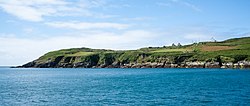Cape Clear Island
| Cape Clear Island Irish: Cléire | |
 Clear Island's South Harbour | |
|---|---|
| Location | |
| Location: | 51°26’13"N, 9°29’52"W |
| Grid reference: | V959215 |
| Area: | 2½ square miles |
| Data | |
| Population: | 147 (2016) |
Clear Island or Cape Clear Island is an island off the south-west coast of County Cork. This is the southernmost inhabited part of Ireland. It has a population of 147 people: it is an official Gaeltacht area, which is to say an Irish-speaking area), and most inhabitants speak Irish and English.
The island is known in the Irish language as Cléire, and sometimes also called Oileán Chléire[1][2]
The nearest neighbouring island is Sherkin Island, which is just over a mile east of the Cape Clear Island. The island is divided into east and west halves by an isthmus called the Waist, with the North Harbour to the landward side and the South Harbour on the seaward side.[3] Ferries sail regularly from the North Harbour to Schull and Baltimore on the mainland. The South Harbour is a popular berth for yachts and pleasure boats.
History
Archaeological sites on the island include a prehistoric cup-marked stone (currently in the island's museum), a fulacht fiadh at Gort na Lobhar, a neolithic passage tomb at Cill Leire Forabhain, several standing stones around the island, a promontory fort at Dún an Óir, and a signal tower dating from the Napoleonic Wars.[4][5]
The island also has a number of early Christian sites, and is reputed to be the birthplace of St Ciarán of Saigir. The ruins of a 12th-century church are close to the main pier in the North Harbour.[6]
The island had a population of over 1,052 before the Great Famine in the 19th century, but the current population of Cape Clear is less than one-eighth of that figure. The island's primary school was built in 1897.
Cape Clear was originally supplied with electricity produced by diesel generators on the island, but around 1995 these were replaced with a submarine power cable from the mainland.[7]
Culture and language
The island is officially identified as a Gaeltacht (Irish-speaking) area. According to the 2016 census there were 145 people over the age of 3 living on the island, with 62% claiming to be able to speak Irish and 27% saying they spoke Irish daily outside the education system.
The population of the island increases in the summer months as students visit the local Irish Colleges, Coláiste Phobal Chléire and Coláiste Chiaráin.[8] Students stay in local houses or dorms and improve their spoken Irish as part of the immersion courses within the Gaeltacht.
Every first weekend of September, the island hosts the Cape Clear Island International Storytelling Festival. The festival has been running annually since 1994.[9]
Wildlife
Seals, basking sharks and dolphins are often found in the surrounding waters. Sea pinks and honeysuckle are common plants on the land.[10]
A lighthouse and a bird observatory stand on the island. Cape Clear is popular with bird watchers and at certain times of the year is home to many species of migratory birds as its climate is milder than the mainland and thus more attractive. Bird life includes black and common guillemots, cormorants and storm petrels.
In literature
Novels involving Clear Island include:
- Ghostwritten by David Mitchell (1999, has one of its stories ('Clear Island') set here.
- The Night Swimmer by Matt Bondurant (2012)
Outside links
| ("Wikimedia Commons" has material about Cape Clear Island) |
References
- ↑ "Cléire / Clear Island (island or archipelago, civil parish)". Irish Placenames Commission. https://www.logainm.ie/543.aspx.
- ↑ "Cléire / Cape Clear (electoral district)". Irish Placenames Commission. https://www.logainm.ie/1372086.aspx.
- ↑ David Walsh, Oileáin: A Guide to the Irish Islands (Pesda Press, 2004; ISBN 0953195694), p. 64.
- ↑ "Cape Clear Heritage Centre". Cape Clear Cooperative. http://www.capeclearisland.ie/heritageCentre.
- ↑ "Cape Clear Island - Oileán Chléire". Fáilte Ireland. http://www.discoverireland.ie/Arts-Culture-Heritage/cape-clear-island-oilean-chleire/62096.
- ↑ Archaeological Inventory of County Cork, Vol 1 (West Cork). Office of Public Works. 1992. ISBN 9780707601755.
- ↑ "Cape Clear Museum and Archive". Capeclearmuseum.ie. http://www.capeclearmuseum.ie/gallery.php. "Electricity and house water was a 'luxury' that only arrived on the island in the 1970s and a submarine cable bringing electricity from the mainland 8 miles away arrived only about 1995."
- ↑ "Irish Colleges". http://capeclearisland.ie/IrishColleges.
- ↑ "Cape Clear Storytelling". http://capeclearstorytelling.com/.
- ↑ John Akeroyd, ed (1996). The Wild Plants of Sherkin, Cape Clear and adjacent Islands of West Cork. Sherkin Island Marine Station. ISBN 9781870492584.
- Cape Clear Island, Éamon Lankford, 1999
- Staideár Cuimsitheach Teangeolaíoch ar Úsáid na Irish sa Ghaeltacht, Committee of Community, Rural and Gaeltacht Affairs, 2007
| Carbery's Hundred Isles in County Cork |
|---|
|
Cape Clear Island • Sherkin Island • Long Island • Castle Island • Carthy's Islands • Horse Island • West Skeam Island • East Skeam Island • Heir Island • Calves Island (West, Middle, East) • Spanish Island • Ringarogy Island • Goat Island (Beg/Mór) • Rabbit Island |
